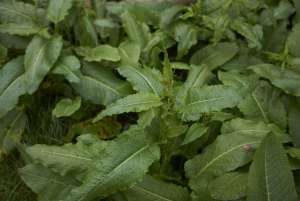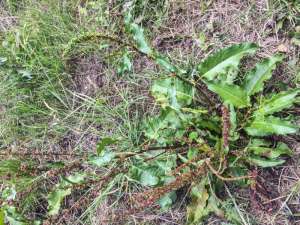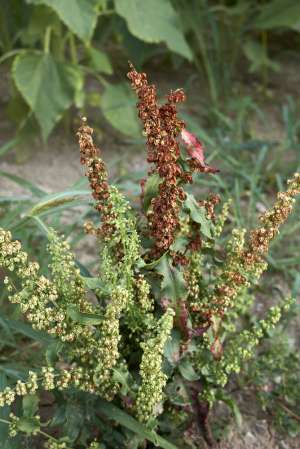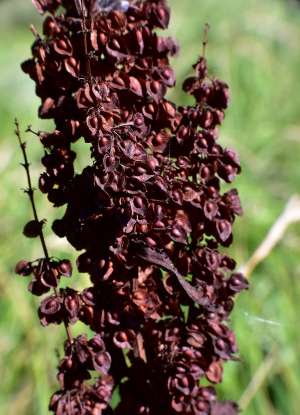Curly dock (Rumex crispus) is one of the many wild edible invasive plants we have in North America.
It's toxic to horses, cattle, and sheep, and the seeds are poisonous to poultry, so it's not something you want in your pasture. And if you do have it, it's not easy to get rid of.
It doesn't really take over like some other "nuisance" plants (ground ivy for instance) but it can be somewhat difficult to deal with in your garden.
Any effort to remove this tenacious weed is usually rewarded with more of it. Each chunk of root left behind will sprout a new plant, so pulling and digging just makes more work if you don't get all of it the first time.
But it is edible, so you could just treat it as a crop when it's young and tender enough to eat.

Curly dock (Rumex crispus) leaves
Identification
Leaves
Curly dock gets its name from its leaves -- they have "curly" or wavy edges.
They initially grow from a basal rosette. When the plant gets older and sends up a flower stalk, leaves will also grow alternately off of the stalk.
They're hairless and mostly green but tend to get tinged with rusty red as they get older. They can grow up to ten or 12 inches long and 2.5 inches wide.
The leaves are joined to the rosette by petioles (leaf stems) which are encased at the leaf node by a thin sheath called an ocrea.
They start out rolled up length-wise, appearing more as a stem than a leaf.
At this point, they're really mucilaginous, which makes them slimy. Just after they unroll, the leaves will start to dry out, but the stems and sheaths will still be slimy.
As they get older, the stems will also dry up and the sheaths will get more papery.

Root
The nickname "Yellow dock" is derived from the color of its large, thick taproot, which can grow as long as four feet.
Habitat
Like a lot of other invasive weeds, curly dock will grow in almost any disturbed area, so it's common in pastures and fields, as well as roadsides, construction sites, etc.
It really thrives in more damp soil near creeks, ponds, springs, and other water ways.
Invasive as it is, though, curly dock doesn't seem to be a problem in more pristine, undisturbed areas.
Edible use
Curly dock is in the Polygonaceae family (the buckwheat family), which is the same family that rhubarb belongs to. It's also closely related to garden sorrel (Rumex acetosa), but it's not related to burdock.
Like rhubarb and sorrel, dock is sour. Oxalic acid is what makes it sour.
A little bit of oxalic acid goes a long way, though, and as dock gets older, the sour turns more to bitter and gets potentially dangerous.
But dock leaves, even the younger ones sometimes, are not always tasty enough to eat raw. I believe it depends to a large degree on what type of soil they grow in.
If they're mild enough (sour and not bitter) they can be eaten raw. Otherwise, they'll need to be cooked to help neutralize some of the acid -- not the best way to eat dock...more on that below.
Try harvesting dock leaves as early as you can find them (early spring) when they're still tender and not yet as bitter.
Pick only the smallest rosette leaves -- the ones that are still rolled up or have just unrolled -- and sample them before throwing a bunch raw in a salad.
If the leaves or stems are still slimy, they're still tender enough to eat raw.
Slimy leaves don't exactly sound appetizing, but that's when they're at their best. I like to munch on them straight from my garden at this stage.
If the leaves are so bitter that you need to cook them to make them tender and palatable, you'll end up with a slimy mess.
Some people do boil them in several changes of water, but it's not worth it to me. If I can't find young leaves that are tender and mild, I would rather look for something else to forage.
The mucilage may be good for thickening things like stews, though.
The leaves will remain bitter through the heat of summer and into early fall, but frost will render them edible once again, offering them up as a fall green until they disappear with consistently cold weather. Or you may find dock throughout the winter in warmer climates.
The seeds and stems are also edible. The stems are definitely worth eating. They're usually suitable for eating (for a while) even after the leaves have gotten too tough.
Look for pliable stems that have not gone to flower yet, which is normally late spring/early summer. Once the flower appears, the stems will be tough and fibrous, which makes it unfit for eating.
Even before it flowers, you may need to peel the outside of the stem to get to the more tender, edible core.

Eating the seeds is another story. It's really easy to harvest a bunch of them at the end of summer (and sometimes into winter).
It's not easy separating the tiny seeds from the chaff, though. Everyone I know of who eats or has eaten them, has resorted to grinding seed and chaff together into a flour.
The chaff can be bitter, which of course makes the whole thing bitter, but if you don't mind that, go for it. And if you know of a good way to winnow the seeds or remove the chaff, please let me know.

Similar species
Broad-leaved dock, aka Broadleaf dock or Bitter dock (Rumex obtusifolius) is another introduced species that's comparable to Curly dock in flavor and palatability.
Visually, the biggest difference is the shape of the leaves. Broad-leaved dock has wider leaves that start out as heart-shaped to oval and get more elliptical or lance-shaped as they get bigger.
Its leaves do get slightly wavy as they get bigger, but the leaf margins are generally flatter than those of Rumex crispus.